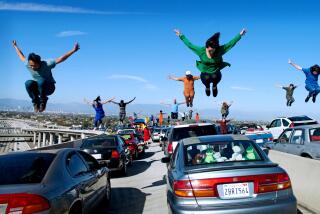Llamas Haltingly Strut Their Stuff : Animal shows: Although they pack a lot of stubbornness, the woolly, long-necked beasts prove to be crowd pleasers at the Antelope Valley Fair.
- Share via
If this was his night to shine at the Antelope Valley Fair, someone had forgotten to tell Patrick Duffy, a 300-pound llama whimsically named after a television celebrity.
The stage was set, the lights were bright and a crowd of 200 was in place for the Antelope Valley’s first officially sanctioned llama show. But when the competition started Patrick Duffy didn’t.
When it came time to walk over a small, wooden platform, he went around. Asked to hop over a low bar, he knocked it down. And when a puddle of water loomed ahead, he stopped, bent his long neck down to sniff gingerly, and then decided not to wet his feet.
“I don’t think he’s ever had practice at anything like this,” Chris Miller, the animal’s handler, said apologetically. Owner Bob Mallicoat was more resolute, suggesting that llamas avoid obstacles because that’s smarter than going through them.
To be sure, Patrick Duffy, named after the actor who plays Bobby Ewing in the “Dallas” television series, would win no awards on opening night of the fair in Lancaster. But no one seemed to mind.
Indeed, the 20 animals participating in the llama show Friday were crowd pleasers, sometimes as much for what they wouldn’t do as what they did, drawing stares and attention from passersby.
The llama competition, one of the few such events in Los Angeles County, was organized by Mallicoat, a Beverly Hills attorney who, with his wife, Caye, has been raising and breeding llamas at their ranch in the Leona Valley west of Palmdale for a dozen years.
For organizers of the 52nd annual fair, the competition was a chance to try something different to stir up interest. For llama breeders and owners who came from throughout Southern California, the competition was an opportunity to spread the lore of the llama to the uninitiated.
“It has the unique feature that everybody loves the llama. People look at the big eyes and they look at the aristocratic posture, and they say, ‘Oh, I’d love to have a llama,’ ” said Mallicoat, who tends to 28 llamas at home and says he has sold 70 more over the years.
Mallicoat names most of his llamas after movie and television stars. Miller and her husband, Dean, help manage the animals at Mallicoat’s Pitchfork Ranch, one of at least 10 rural locations in the Antelope Valley where llamas are kept for pets or breeding.
The long-necked, woolly llama is a humpless member of the camel family mostly found in South America. Although historically used as pack animals, the creatures, which can weigh up to 450 pounds, have become increasingly popular in the United States as pets.
There are 20,000 to 25,000 llamas in the United States, according to estimates, and the numbers grow each year. Publisher William Randolph Hearst is believed to have helped establish them on the West Coast in the 1920s by importing some for his San Simeon castle retreat.
Friday’s 2 1/2-hour llama competition featured four events: the obstacle course, a public relations exercise to test how the animals react in various encounters, a costume judging, and a timed relay race in which the animals and their handlers circled the inside of the indoor arena.
Fortunately for the handlers and the audience, not all of the llamas were as obstinate as Patrick Duffy, who was pressed into service at the last minute so the event would have the minimum 20 animals required by the sanctioning American Llama Show Assn.
“Very few of the animals came in absolutely cold. Most of the people have some sort of obstacle course at home,” said Kathleen McLeod, a breeder from the small town of Ramona in San Diego County who took the top prize for the event and had two llamas entered.
McLeod’s llama, The Marksman, trotted agilely through the obstacle course, taking first place. And her Middle Eastern-style garb with a sign on her llama poking fun at Iraqi leader Saddam Hussein was good for a second-place finish in the costume event.
Overall, though, there was a fair share of halting, starting and stumbling as handlers used halters to guide their llamas around the arena. In the relay race, for instance, some handlers had to virtually drag their slow animals across the finish line--and llamas do not drag easily.
“Llamas don’t do much really. They do what they want to do. They’ve got their own attitude,” April Boenzi, 16, of Lancaster said as she watched from the grandstands. “I think the smarter the animal, the less they do.”
To listen to llama lovers, though, one would think the animals have nary a negative trait. They’re described as calm, clean, gentle, quick to learn, sure-footed, friendly toward most other animals, unceasingly curious, and easy on the budget, eating only about a fourth as much as horses.
Perhaps because of the competition, the llamas withheld their one unpleasant habit, a tendency to spit and hiss when annoyed or provoked. And since the event was held after dark, the crowd missed another curious llama quirk: facing the sun at sunrise and sunset and emitting loud groans.
More to Read
Sign up for Essential California
The most important California stories and recommendations in your inbox every morning.
You may occasionally receive promotional content from the Los Angeles Times.













